Often called the Philippines’ last ecological frontier, Palawan’s rich biodiversity is very impressive but also so very fragile. Yet for the 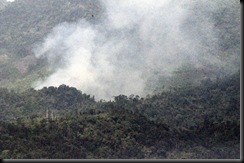 month of April this year alone, in northern Palawan alone, the burning of swathes of mountain slopes was a near daily occurrence. Plumes of smoke could be seen from surrounding mountains signaling slash and burn activity. It was as if a concerted effort to destroy the island’s capacity to support life is being waged.
month of April this year alone, in northern Palawan alone, the burning of swathes of mountain slopes was a near daily occurrence. Plumes of smoke could be seen from surrounding mountains signaling slash and burn activity. It was as if a concerted effort to destroy the island’s capacity to support life is being waged.
Travelling toward the 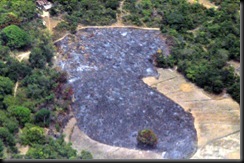 eastern side of El Nido, we passed quite a few blackened areas, tell-tale signs of swidden farming or kaingin. Meriam Arzaga of the El Nido Foundation provides an interesting observation: that incidences of kaingin increase after a tag-hirap year – a year when crops fall short of what is needed. It is a method farmers seem to resort to, to augment harvests from their regular rice fields.
eastern side of El Nido, we passed quite a few blackened areas, tell-tale signs of swidden farming or kaingin. Meriam Arzaga of the El Nido Foundation provides an interesting observation: that incidences of kaingin increase after a tag-hirap year – a year when crops fall short of what is needed. It is a method farmers seem to resort to, to augment harvests from their regular rice fields.
Swidden farming, or kaingin, is most obvious during the dry months when plots are prepared by burning vegetation therein, awaiting the first 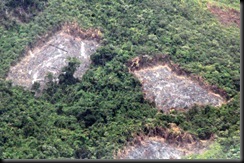 rains before planting. It has been in practice for generations in many parts of the world, benignly, even favorably, viewed in such literature as Alan Paton’s Cry, the Beloved Country (1948) and NVM Gonzales’ Children of the Ash-Covered Loam (1954). It is a method developed over the centuries as a means to reduce pests and facilitate the migration of biological control agents, such as insect parasites and predators, from the surrounding forests.
rains before planting. It has been in practice for generations in many parts of the world, benignly, even favorably, viewed in such literature as Alan Paton’s Cry, the Beloved Country (1948) and NVM Gonzales’ Children of the Ash-Covered Loam (1954). It is a method developed over the centuries as a means to reduce pests and facilitate the migration of biological control agents, such as insect parasites and predators, from the surrounding forests.
For the system to be sustainable (myopically ignoring its impact on 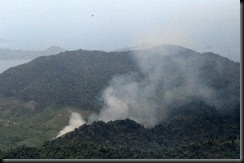 global warming and ocean siltation, that is), a plot, after being used for a few years, must be allowed to fallow for about 20 years before beginning the cycle again. In this period, the soil is allowed to rest and regain the nutrients that only time left alone can provide. But when the number of people the land has to support becomes so great that the fallow periods are drastically reduced, productivity declines and the system becomes destructive, eventually working its way into new areas in the forest.
global warming and ocean siltation, that is), a plot, after being used for a few years, must be allowed to fallow for about 20 years before beginning the cycle again. In this period, the soil is allowed to rest and regain the nutrients that only time left alone can provide. But when the number of people the land has to support becomes so great that the fallow periods are drastically reduced, productivity declines and the system becomes destructive, eventually working its way into new areas in the forest.
When a farmer begins cutting the fringes of public land in 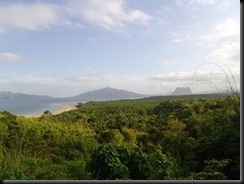 preparation for burning, Meriam explains, no one else but the farmer who torched it gets to plant on it when the rains come. It is a tradition of respect among kaingin farmers that has been observed for as long as anyone can remember.
preparation for burning, Meriam explains, no one else but the farmer who torched it gets to plant on it when the rains come. It is a tradition of respect among kaingin farmers that has been observed for as long as anyone can remember.
But if kaingin activity is that plain to see and the culprits so easily identifiable, why isn’t anyone doing anything to apprehend the offenders? To be sure, unauthorized burning of forest and grazing  land is illegal under the Revised Forestry Reform Code. Moreover, a 1998 presidential proclamation declared all of El Nido and Taytay, its adjacent municipality, as a Protected Area, putting it under the supervision of the Department of Environment and Natural Resources, with its own Protected Area Superintendent. Whether it is for lack of political will or simple bureaucratic laziness, solutions, for now at least, do not seem to be forthcoming from any government enforcement effort.
land is illegal under the Revised Forestry Reform Code. Moreover, a 1998 presidential proclamation declared all of El Nido and Taytay, its adjacent municipality, as a Protected Area, putting it under the supervision of the Department of Environment and Natural Resources, with its own Protected Area Superintendent. Whether it is for lack of political will or simple bureaucratic laziness, solutions, for now at least, do not seem to be forthcoming from any government enforcement effort.
It isn’t that the farmers are not aware of the illegality of kaingin or its implications; often, they do it because they feel they need 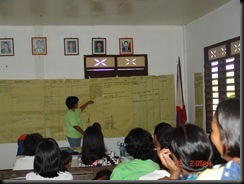 to. Apparently, if farmers have to choose between putting food on the table and obeying some law, the former will always win hands-down. The answer must lie in providing an alternative to kaingin.
to. Apparently, if farmers have to choose between putting food on the table and obeying some law, the former will always win hands-down. The answer must lie in providing an alternative to kaingin.
At the eastern villages of Mabini, New Ibajay, Sibaltan and Villa Paz, Seacology provided cashew production equipment, among others, as an alternative livelihood enterprise in exchange for the establishment of a 470-acre marine protected area and 2,408-acre mangrove protected area. In this project, the villagers have 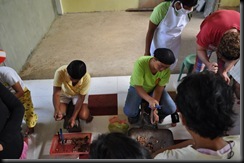 committed themselves to actively protect these resources, with the municipal government and DENR relegated to a supporting role. Even the local parish priest, Fr. Ed Parino, has taken an active role in the enforcement of the protected areas, and has been instrumental in the apprehension of poachers from out-of-town. And as alternative livelihoods go, the brisk sales of their cashews at the upscale resorts of El Nido are certainly encouraging.
committed themselves to actively protect these resources, with the municipal government and DENR relegated to a supporting role. Even the local parish priest, Fr. Ed Parino, has taken an active role in the enforcement of the protected areas, and has been instrumental in the apprehension of poachers from out-of-town. And as alternative livelihoods go, the brisk sales of their cashews at the upscale resorts of El Nido are certainly encouraging.
There is still much to appreciate in northern Palawan in terms of rich 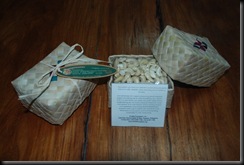 natural resources. But to preserve it, the focus has to shift from what the communities should not do, to what they can do instead.
natural resources. But to preserve it, the focus has to shift from what the communities should not do, to what they can do instead.
No comments:
Post a Comment